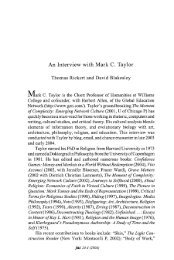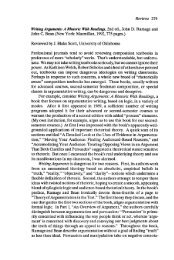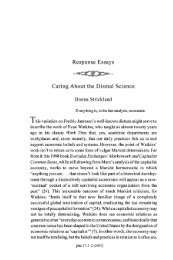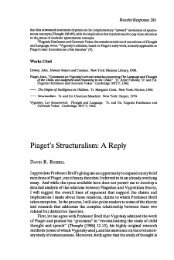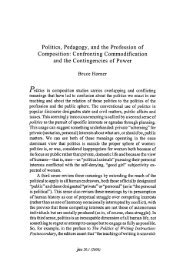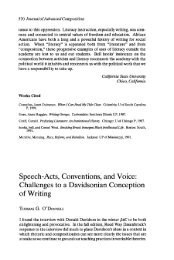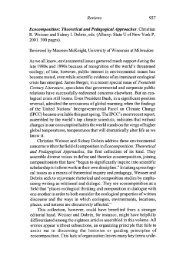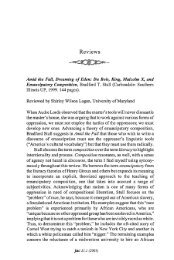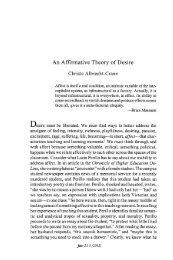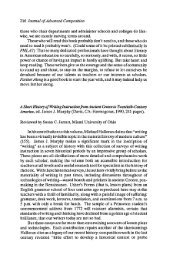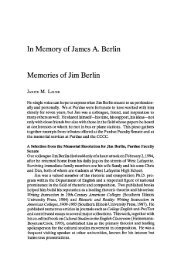Nance Van Winckel Pausing, or the act of reflection ... - JAC Online
Nance Van Winckel Pausing, or the act of reflection ... - JAC Online
Nance Van Winckel Pausing, or the act of reflection ... - JAC Online
Create successful ePaper yourself
Turn your PDF publications into a flip-book with our unique Google optimized e-Paper software.
<strong>Nance</strong> <strong>Van</strong> <strong>Winckel</strong> 105<br />
and subconsciousness are made by G<strong>or</strong>don and Poze <strong>the</strong>mselves<br />
in this article. Preconsciousness <strong>the</strong>y see largely in terms <strong>of</strong><br />
thought that observes both w<strong>or</strong>ds and images coming toge<strong>the</strong>r,<br />
<strong>the</strong> place where shutding between left and right brains occurs,<br />
where communication between consciousness and subconsciousness<br />
is most possible. (See W. J. J. G<strong>or</strong>don and Tony Poze,<br />
"Conscious/Subconscious Inter<strong>act</strong>ion in a Creative Act," The<br />
Journal <strong>of</strong> Creative Behavi<strong>or</strong>, 15 (First Quarterly, 1981.) The<br />
second step is to establish a nonverbal image <strong>of</strong> that functional<br />
(verbal) essence-a movement from left to right brain, involving<br />
preconscious thought. Next <strong>the</strong> right brain takes over. It transf<strong>or</strong>ms<br />
<strong>the</strong> nonverbal image into one that's different but similar.<br />
The fourth step is linking that image to a name, <strong>or</strong>, a passing<br />
through preconsciousness again, moving back from right to left<br />
brain. The last step belongs to <strong>the</strong> verbal analyzer, <strong>the</strong> left<br />
brain, which compares <strong>the</strong> new image to <strong>the</strong> <strong>or</strong>iginal to determine<br />
<strong>the</strong> quality <strong>of</strong> <strong>the</strong> fit.11 F<strong>or</strong> example, if one were asked<br />
to make a metaph<strong>or</strong> f<strong>or</strong> a new moon, he <strong>or</strong> she would probably<br />
begin by imagining a visual image <strong>of</strong> <strong>the</strong> sliver <strong>of</strong> yellow moon.<br />
This functional essence would <strong>the</strong>n be transf<strong>or</strong>med into a similar<br />
image, something else that is slighdy wedge-shaped and yellowish.<br />
After a new visualization emerges, say an image <strong>of</strong> a lemon<br />
slice, it moves to <strong>the</strong> left brain and in so doing, receives a name<br />
"lemon slice." Finally, <strong>the</strong> left brain analyzes this new image to<br />
see how well it resembles <strong>the</strong> <strong>or</strong>iginal subject.<br />
These five steps involve both a deliberate and conscious<br />
focusing and an equally deliberate and conscious unfocusing, a<br />
purposeful employment <strong>of</strong> ambiguity, which I will soon look at<br />
in greater depth. Focusing, we can conclude, becomes a liability<br />
when one cannot unfocus, when one holds so tighdy to <strong>the</strong> <strong>or</strong>iginal<br />
subject that it cannot blur, that it cannot become an "o<strong>the</strong>r"<br />
capable <strong>of</strong> generating m<strong>or</strong>e <strong>or</strong>iginal, emotive, <strong>or</strong> insightful ideas.<br />
This recursiveness <strong>of</strong> thinking, <strong>or</strong> <strong>the</strong> "shutding" between<br />
consciousness and subconsciousness which occurs frequendy<br />
during composing, may no doubt account f<strong>or</strong> <strong>the</strong> <strong>of</strong>ten heard<br />
comment that Stallard mentions: "I'm trying to find <strong>the</strong> right<br />
w<strong>or</strong>ds to fit this idea." The emergence <strong>of</strong> subconscious w<strong>or</strong>dless<br />
ideas through preconsciousness to consciousness defines in a<br />
sense <strong>the</strong> way one discovers meaning-by naming <strong>or</strong> by trying to<br />
name one's thoughts.



